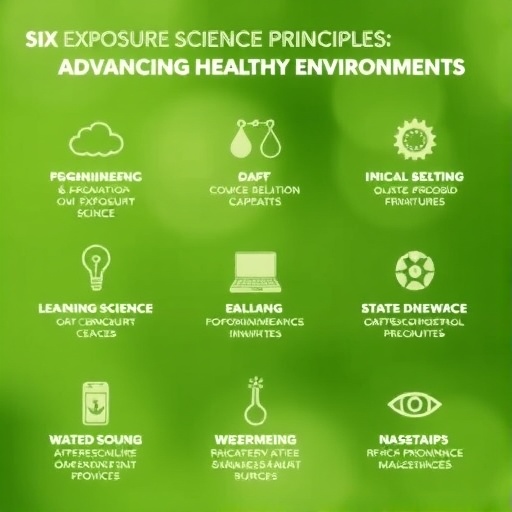
In the evolving landscape of environmental health, understanding the intricate ways in which humans interact with their surroundings is paramount. Exposure science, a discipline that discerns how individuals come into contact with environmental agents, stands at the forefront of this endeavor. A recent seminal publication by E.A. Cohen Hubal delineates six foundational principles of exposure science, charting a transformative path for the future of environmental health research. This work not only elucidates the theoretical framework of exposure science but also compellingly advocates for innovative, solution-driven approaches that prioritize healthier environments on a global scale.
At its core, exposure science investigates the magnitude, frequency, and duration of contact between humans and chemical, physical, or biological stressors in their environments. These stressors range from air pollutants and contaminated water to radiation and microbial agents. Understanding this contact is crucial because it directly influences the risks posed to human health and guides regulatory actions to mitigate those risks. Druck from policymakers and health professionals alike has heightened the demand for precise exposure assessment methodologies, and Cohen Hubal’s principles present a timely blueprint to meet this need.
A key revelation in Cohen Hubal’s treatise is the imperative of integrating interdisciplinary perspectives. Exposure science cannot thrive in isolation; it requires the harmonization of toxicology, epidemiology, environmental chemistry, and data science. By fostering collaborations across these domains, researchers can derive more comprehensive exposure profiles and unearth subtle exposure pathways previously overlooked. This cross-pollination of expertise accelerates the discovery of actionable insights that could ultimately transform public health interventions and environmental policies.
.adsslot_jIBCn7U2Xq{ width:728px !important; height:90px !important; }
@media (max-width:1199px) { .adsslot_jIBCn7U2Xq{ width:468px !important; height:60px !important; } }
@media (max-width:767px) { .adsslot_jIBCn7U2Xq{ width:320px !important; height:50px !important; } }
ADVERTISEMENT
Moreover, these principles emphasize the critical role of precision measurement technologies and innovative modeling techniques. Traditional exposure assessments often rely on broad estimates or proxy data, which may fail to capture nuanced variations in exposure across populations and temporal scales. Emerging tools such as wearable sensors, real-time environmental monitors, and advanced computational models offer unprecedented resolution, enabling researchers to pinpoint exposures with greater fidelity. Cohen Hubal argues that adopting these technologies systematically will enable dynamic, individualized risk assessments tailored to diverse demographic and geographic contexts.
Another foundational concept outlined is the prioritization of vulnerability and susceptibility within exposure assessments. Not all individuals bear equal risk; factors such as age, genetic predisposition, socio-economic status, and preexisting health conditions modulate vulnerability to environmental exposures. The principles advocate for embedding this heterogeneity into exposure science frameworks, ensuring that vulnerable groups receive targeted attention. This approach aligns with principles of environmental justice, seeking to rectify disproportionate burdens borne by marginalized communities.
Importantly, Cohen Hubal highlights the necessity of transparency and open access in exposure data dissemination. In the digital age, democratizing exposure information engenders public trust and empowers communities to advocate for healthier environments. Platforms that enable real-time sharing of exposure data also facilitate rapid response mechanisms during environmental crises, such as chemical spills or wildfire smoke events. By championing openness, exposure science transitions from an esoteric discipline into a public health ally accessible to diverse stakeholders.
The publication also underscores threats posed by rapidly changing environmental conditions driven by climate change and urbanization. Exposure profiles are dynamic; increasing temperatures, novel pollutant sources, and shifting land use patterns recalibrate the landscape of human-environment interactions. The six principles urge researchers to incorporate adaptability into exposure frameworks, allowing for continuous monitoring and responsive revision of risk models. This adaptive capacity is vital for maintaining relevance in an era marked by environmental unpredictability.
Cohen Hubal further advocates for strengthening the linkage between exposure assessment and toxicological effect data. Historically, exposure data and health outcome data have often been siloed, limiting causal inferences. Bridging this divide facilitates more robust identification of exposure thresholds and elucidates mechanisms underlying toxicity. Exposure science, thus envisioned, becomes not only descriptive but predictive, capable of informing preemptive public health strategies before widespread harm manifests.
Education and capacity building emerge as a pivotal element within these principles. The expanding complexity of exposure science demands a workforce proficient in both technological innovations and conceptual frameworks. Training programs that foster interdisciplinary learning and critical thinking are essential to cultivate the next generation of exposure scientists poised to navigate this multifaceted field. Cohen Hubal calls for institutional reforms and investments that ensure sustained human capital for exposure science endeavors.
The narrative also touches on the utilization of citizen science and community engagement in advancing exposure science. By involving laypersons in data collection and interpretation, researchers can access granular, localized exposure insights while simultaneously cultivating environmental stewardship. This participatory model democratizes science and imbues it with social relevance, ultimately enhancing the impact and ethical grounding of exposure science initiatives.
From a policy standpoint, the principles advocate for embedding exposure science into the regulatory fabric of environmental governance. Policies grounded in empirically rigorous exposure data have enhanced legitimacy and efficacy. Moreover, exposure science can identify emerging contaminants and exposure scenarios early, enabling precautionary regulatory action. Cohen Hubal’s work calls for strengthened communication channels between scientists and policymakers to translate complex exposure data into actionable regulatory measures seamlessly.
Technological innovation is further envisioned in data integration and management. Exposure data often span diverse scales—from molecular-level biomarkers to landscape-scale pollutant distributions—and originate from heterogeneous sources. The principles endorse leveraging big data analytics, machine learning, and interoperable databases to synthesize this information efficiently. Such integration enhances the capacity to detect patterns, predict outcomes, and tailor interventions with unprecedented sophistication.
Ethical considerations permeate the discourse as well. Exposure science must navigate privacy concerns related to personal exposure data collection and use. Ensuring informed consent and safeguarding sensitive information are fundamental to maintaining ethical integrity. Additionally, equitable access to exposure reduction technologies and interventions must be prioritized to prevent exacerbation of health disparities. These ethical imperatives are integral to fostering trust and social license for exposure science applications.
Cohen Hubal’s principles ultimately present a visionary yet pragmatic roadmap for exposure science, harmonizing scientific rigor with societal needs. The articulation of six distinct yet interrelated principles offers a scaffold upon which the field can innovate while remaining grounded in fundamental objectives—understanding, mitigating, and ultimately preventing harmful environmental exposures. This comprehensive approach holds promise for catalyzing breakthroughs that will reverberate through public health, regulatory science, and community well-being.
The implications of adopting these principles are vast. Integrating them can transform environmental health risk assessment into a proactive, precision-oriented discipline. By deploying cutting-edge tools, engaging diverse stakeholders, and maintaining flexible, ethical frameworks, exposure science can evolve into a cornerstone of 21st-century environmental health protection. Cohen Hubal’s incisive exposition serves as a clarion call to researchers, policymakers, and communities alike to rally behind exposure science’s potential to foster healthier environments worldwide.
In an era where environmental challenges are increasingly complex and intertwined with social determinants of health, the six principles of exposure science provide a beacon of clarity and direction. They invite a paradigm shift from reactive responses to anticipatory, evidence-based interventions. Such transformation is pivotal to safeguarding human health amid escalating environmental pressures—marking a critical milestone in the journey toward sustainable coexistence between humanity and the environment.
As exposure science continues to mature, iterative evaluation and refinement of these principles will be essential. Real-world applications, technological advancements, and evolving scientific insights will inform their evolution, ensuring their enduring relevance. The publication by Cohen Hubal stands as an authoritative foundation and inspiration, charting a course toward a future where exposure science fulfills its promise as a driver of healthier, more equitable environments.
Subject of Research:
The foundational principles guiding exposure science and its role in fostering healthy environments through interdisciplinary approaches, technological innovation, and ethical engagement.
Article Title:
Six principles of exposure science: inspiring solutions that foster healthy environments.
Article References:
Cohen Hubal, E.A. Six principles of exposure science: inspiring solutions that foster healthy environments. J Expo Sci Environ Epidemiol (2025). https://doi.org/10.1038/s41370-025-00791-1
Image Credits: AI Generated
Tags: chemical and physical stressorsenvironmental health researchenvironmental risk assessmentexposure science principlesglobal health solutionshealthier environments advocacyhuman-environment interactionsinnovative exposure assessment methodologiesinterdisciplinary approaches in sciencepolicy-driven environmental healthtransformative environmental researchunderstanding environmental agents



